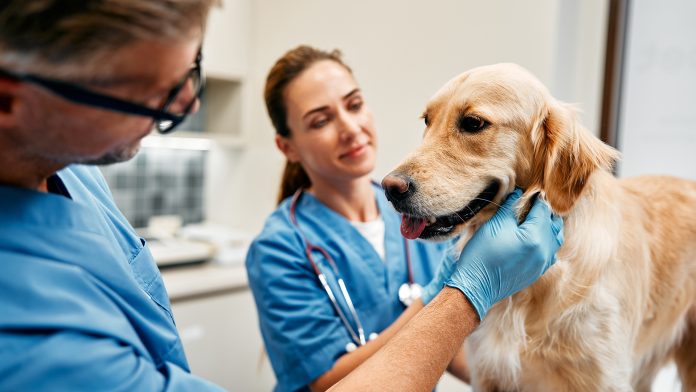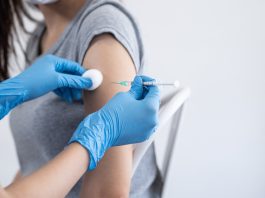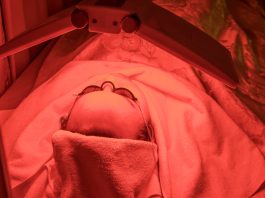Dr Morgan Jeannin from the World Organisation for Animal Health details the actions we can take towards tackling antimicrobial resistance in animals and humans alike, as part of a One Health approach.
Antimicrobial resistance (AMR) – which occurs when the microorganisms which cause disease are no longer affected by antimicrobial medicines – has become one of the most pressing global health issues today. Not only is it a major threat to humans, it also affects animals, plants and the environment. Tackling and reducing this threat therefore requires a multi-sectoral approach and everyone has a role to play.
The World Organisation for Animal Health (WOAH), the global authority on animal health, joins forces with other major health organisations across the globe to deliver a ‘One Health’ approach to tackling AMR. Editor Georgie Purcell spoke to Dr Morgan Jeannin, Chargé de mission at WOAH’s Antimicrobial Resistance and Veterinary Products Department, to learn what actions we can take to reduce the threat of antimicrobial resistance in animals and humans alike.
How much of a threat is antimicrobial resistance in animals?
Antimicrobial resistance occurs when bacteria, viruses, fungi, and parasites stop responding to the medicines that we use to fight them, leading to infections becoming difficult or impossible to treat. This increases the risk of disease spread, severe illnesses and even death, both in animals and humans alike.
In the animal sector, AMR undermines the efficacy of critical medicines used, making it harder to treat common infections. This can lead to a widespread crisis in terms of animal health and welfare. As well as the immediate threat to animal health, we must also consider the big picture here when it comes to food-producing animals. AMR can have a major impact on the food system’s productivity and people’s livelihoods, as one in five people around the world today directly depend upon the production of animals for their incomes and livelihoods.
We must remember that, as organisms on this Earth, we share the same planet and we are all therefore connected – what we do in one sector will have an impact on another sector. If we use antimicrobials non-prudently in animals, which could increase the resistance of bacteria, we don’t know to what extent these bacteria could also lead to resistance in humans and vice-versa.
In September, the United Nations General Assembly held a High-Level Meeting on AMR resistance. Here, world leaders committed to take decisive actions against antimicrobial resistance. They unanimously adopted a new political declaration containing 44 commitments, four of which are specific to the animal health sector. The idea behind these commitments and this political declaration is taking a ‘One Health’ approach, recognising that the impact of antimicrobial resistance in one sector affects them all.
If no action is taken, the impact of AMR on livestock in the animal sector alone could reduce the global GDP by up to $74bn per year by 2050. In a worst-case scenario, by 2050, production losses in the livestock sector could be equivalent to the consumption needs of more than two billion people per year. Those are just some of the results that were published during the UN Meeting through the EcoAMR report, which was published by a consortium of partners led by WOAH. If we start looking from a broader lens, drug-resistant bacteria know no borders between species spreading across human and animal health as well as the environment. In terms of economic fallout, we could lose trillions and see up to 30 million human deaths by 2050.
AMR is a threat not only in the animal health sector, but to us all. We need to tackle this issue together.
What are the actions needed to reduce the threat of antimicrobial resistance?
I like the term reducing the threat instead of making it disappear. AMR is a natural phenomenon where microorganisms evolve and become resistant upon exposure to different antimicrobials. Alexander Fleming warned us when he discovered penicillin that, with every new antimicrobial that will be developed, resistance will inevitably appear. A world completely without resistance is hard to imagine. However, we can learn how to live in a world where we can use antimicrobials responsibly and sustainably, and reduce the burden of AMR in the animal and human health sectors.
At WOAH, we are working to make sure that every actor in the animal health sector is aware that we must use antimicrobials responsibly to ensure that they remain available for future generations. In terms of concrete actions, it’s taking this One Health approach and recognising that we’re all interconnected.
In the recent United Nations General Assembly political declaration, one of the commitments was to meaningfully reduce antimicrobial use by 2030, emphasising the importance of prevention strategies such as improving biosecurity in farms. Prevention starts with good hygiene, good husbandry and farming practices, as well as making sure that all countries have access to high-quality vaccines, which will reduce the need for antimicrobials.
The World Organisation for Animal Health is the global authority on animal health and we are a standard setting organisation. This means our 183 Members across the globe are committed to complying to the animal health and welfare standards that we develop. We are also focused on creating better public health, better and safer trade, and encouraging economic growth within and beyond the borders of these countries.
We are developing a new chapter on biosecurity within our code of standards, hoping that it will promote best practices on farms for increased disease prevention. We are also committed to keeping our standards and guidelines updated to the latest scientific evidence. We have a priority list of vaccines that could reduce the need for antimicrobials, and we have committed to refining this list to make it a valuable asset for our Members.
My leading area of work is in monitoring. If you cannot measure a problem, you cannot solve it. It is, therefore, essential that we monitor how we are using antimicrobials. WOAH has a global database called ANIMUSE (Animal Antimicrobial Use), which provides countries with the tools to track and assess their consumption of antimicrobials in animals. This will help them in setting targets and to identify the areas in which they should reduce their antimicrobial use. It collects data from around 160 countries around the world and we have been supporting these countries in this endeavour for over a decade. It provides a critical baseline of information for tracking antimicrobial use in the animal health sector. We are now really taking a step forward by supporting countries on how to use that data to start creating their own reports and taking action from that data. The idea is not just about collecting the data, it’s providing them with graphs, visual information, and dashboards so that they can take ownership on their data and take action themselves. We are supporting countries to measure their progress and hopefully supporting them in following the critical targets that were set for antimicrobial use reduction in the UN General Assembly.
How can individuals – from farmers and animal health providers, to pet owners – play a part in fighting antimicrobial resistance in animals?
The depth of the issue is that AMR is not just a scientific or a veterinary challenge; it is a political, economic and societal challenge. The objective of using antimicrobials responsibly is a responsibility we all share. We need to take action today to make sure that we secure a healthier future for us all tomorrow.
Last May, WOAH updated its standards on responsible antimicrobial use. In these standards, we highlighted the key roles and responsibilities that each stakeholder has – from pet owners to farmers to veterinarians, but also the antimicrobial producers and competent authorities. We all have a role to play. This means adhering to the principles I covered previously, including administering antibiotics only when needed, recognising the importance of disease prevention, and implementing the right biosecurity measures. Pet and companion animal owners can contribute by ensuring their pets are well vaccinated against classical diseases, that they receive basic veterinary care, and that they are treated responsibly without asking for antimicrobials as soon as there is a minor or even a non-bacterial disease.
One of the main pillars of importance for every stakeholder is the need for better education and awareness around antimicrobial resistance. Communication is something WOAH has been focusing on heavily recently. For example, we have been renewing our website to make it more accessible and understandable for a non-technical audience. We have also devised dedicated fact sheets tailored to each stakeholder.
How is WOAH contributing to tackling the issue of AMR?
WOAH has developed its own AMR strategy following the Global Action Plan on Antimicrobial Resistance. Our AMR strategy, which was developed in 2017, has four pillars: Awareness, Surveillance, Research, and Capacity Building.
In terms of awareness, having this conversation is already a great example. Raising awareness to a general public audience is really important. Each year sees World AMR Awareness Week take place, which is a global campaign with different actions undertaken in every country to raise awareness and increase understanding of what AMR is and promote best practices among a One Health perspective.
We have numerous activities in the area of surveillance. As mentioned previously, our ANIMUSE database is a key example. In the animal health sector, there is no other data out there equivalent to that collected by ANIMUSE. We also have another system, VSAFE, that we piloted and are now developing to support countries in the detection of falsified and substandard veterinary medical products. The key to having good antimicrobial stewardship is having the right antimicrobials for the right people at the right time, with the right dose. We are already piloting this project in over 60 countries.
In terms of research, I’ve highlighted that at WOAH there is a priority list of vaccines for different species and different diseases for which they could actually reduce the need for antimicrobials. We’ll be looking into refining that list to make sure that it’s a valuable asset for our members.
Collaboration relies on this One Health approach. At an international level, we are part of what we call the Quadripartite. We work hand in hand with the World Health Organization (WHO), the Food and Agriculture Organization (FAO), and the United Nations Environment Programme (UNEP) to tackle the issue across all sectors. We have developed a One Health research priority agenda, which is the product of a collaboration of many stakeholders, with a goal of providing a roadmap of priorities to be tackled in terms of research. One of the points that has been highlighted in the political declarations of the United Nations is the need for innovation for alternatives to antibiotics and for new antibiotics.
Capacity building is one of WOAH’s core mandates. One of the main objectives of our organisation is to support and build capacity within veterinary services, which implement animal health within countries. In addition, alongside our Quadripartite partners, we are involved in the Multi Partner Trust Fund Initiative. This is a big funding initiative in low- and middle-income countries to support them in producing and implementing national action plans on AMR. At a global level, we are scaling up these efforts to develop this Multi Partner Trust Fund to support more and more countries to implement their national action plans.
The global threat of antimicrobial resistance demands that we act decisively. Tackling AMR requires co-operation across all sectors—animal, human, plant and environmental health. WOAH is at the forefront, setting science-based standards to safeguard animal health. Through data collection systems, updated guidelines, and proactive partnerships with other global organisations, WOAH contributes to a One Health approach, ensuring a healthier future for all. In this shared mission, every action counts, from global policy to individual responsibility.
Please note, this article will also appear in the 20th edition of our quarterly publication.









